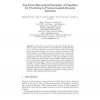420 search results - page 2 / 84 » A graphical model for predicting protein molecular function |
JCC
2008
13 years 5 months ago
2008
: We introduce PULCHRA, a fast and robust method for the reconstruction of full-atom protein models starting from a reduced protein representation. The algorithm is particularly su...
WOB
2008
13 years 6 months ago
2008
Abstract. Despite the recent advances in Molecular Biology, the function of a large amount of proteins is still unknown. An approach that can be used in the prediction of a protein...
BMCBI
2005
13 years 5 months ago
2005
Background: Currently, the PDB contains approximately 29,000 protein structures comprising over 70,000 experimentally determined three-dimensional structures of over 5,000 differe...
ICML
2004
IEEE
14 years 6 months ago
2004
IEEE
In this paper, we present a graphical model for protein secondary structure prediction. This model extends segmental semi-Markov models (SSMM) to exploit multiple sequence alignme...
BIBE
2003
IEEE
13 years 10 months ago
2003
IEEE
The tertiary (3D) structure of a protein contains the essential information for understanding the biological function of the protein at the molecular and cellular levels. Traditio...

